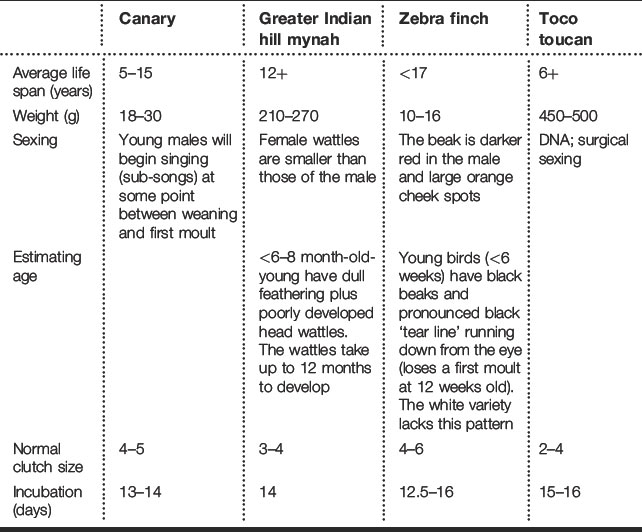Chapter 6 Songbirds and softbills
The passerines (songbirds) and softbills are the other major groups of birds kept for ornamental purposes apart from psittacines, rather than utility species such as pigeons and birds of prey. There is inevitably an overlap between the disorders that occur in psittacines and those that occur in the passerines and softbills. This chapter deals with those diseases and disorders specific to various passerines and softbills, but diagnostic options should be considered in conjunction with the appropriate psittacine section, in Parrots and Related Species.
Commonly kept species include:
• Mynahs including the greater Indian hill mynah (Gracula religiosa intermedia), the lesser Indian hill mynah (Gracula religiosa indica) and the Bali or Rothschild mynah (Leucopsar rothschildi)
• Estrildidae finches including the waxbills (including the zebra finch Poephila guttata), parrot-finches (Erythrura spp and Chloebia spp) and mannikins (Lonchura spp)
Commonly encountered species are listed in Table 6.1.
Skin disorders
Alopecia
• Feather picking – rarely self-mutilation; usually by other birds, especially zebra finches. May indicate iron storage disease in toucans
Nodules and non-healing wounds
• Intracutaneous keratinizing epithelioma has been described in the mynah bird (Rodríguez et al 2006)
• Bumblefoot – typically chronic infection and abscessation of the feet, especially the plantar surfaces
Ectoparasites
• Flies. Hippoboscids (flat flies/louse flies) occasionally encountered especially with aviary birds. Can transmit haemoparasites such as Haemoproteus and Leukocytozoon, as well as transfer mites and lice between individuals
• Lice. Can reach significant numbers on debilitated birds. Particularly induce baldness in canaries secondary to irritation
• Ticks. Occasionally on new imports. Sudden death associated with tick attachment to head. Suggested aetiologies include hypersensitivity reactions, toxin injection or a tick-borne infection. Can also transmit other diseases such as haemoprotozoa, Borrelia spp and louping-ill.
• Quill mites such as Syringophilus, Dermatoglyphus and Picobia spp. Found inside quills. Harpirhynchus mites may induce hyperkeratotic epidermal cysts
Dermatitis
• Commensal bacterial numbers on the skin of birds are considered to be lower than those found on mammals
Management
1 Optimize diet including the use of multivitamin supplements; reducing seed intake and increasing fruit and/or insect consumption where appropriate for the species
2 Where there is significant feather loss, consider supplementary heating to counter loss of insulation
4 If pruritic consider analgesia – meloxicam (Metacam oral suspension) at 1 drop/500 g body weight twice daily. Do not use steroids
Treatment/specific therapy
• Cnemidocoptid mites, e.g. Cnemidocoptes pilae
• Ivermectin at 0.2 mg/kg p.o., s.c. or i.m. A small drop may be applied topically over the jugular vein or on to the back of the neck and seems to work well. Injection is not recommended in birds weighing <500 g due to problems with toxicity. Treat Harpirhynchid, Epidermoptid and Cheyletiellid mites as for Cnemidocoptid mites
• Dermatomycosis (Trichophyton spp and Microsporum spp). Topical ketoconazole preparation and systemic antimycotic, e.g. itraconazole at 5 mg/kg s.i.d. p.o.
Systemic disorders
Respiratory tract disorders
Findings on clinical examination
• Head swinging and neck stretching. Forward-leaning and extended neck strongly suggests tracheal obstruction
Management
1 Improve hygiene. Aeromonad and pseudomonad air sac infections have been associated with infected sprays or misters
Treatment/specific therapy
• Avian pox – supportive care. Avoid access to blood-sucking insects (carriers). May also be spread by contact with infected blood; rarely in contaminated food and drinking water. Vaccination.
• Yersiniosis – appropriate antibiotics. Source of infection is often faecal contamination from wild birds and rodents
• Sarcocystis
• Treat with trimethoprim sulphadiazine (30 mg/kg s.i.d.) plus pyrimethamine 0.5–1.0 mg/kg p.o. b.i.d. for 30 days. May need to supplement with folic acid
• Syngamus spp. Indirect life cycle using earthworms, slugs and snails. Treat with fenbendazole at 50 mg/kg p.o. as a one off dose.




